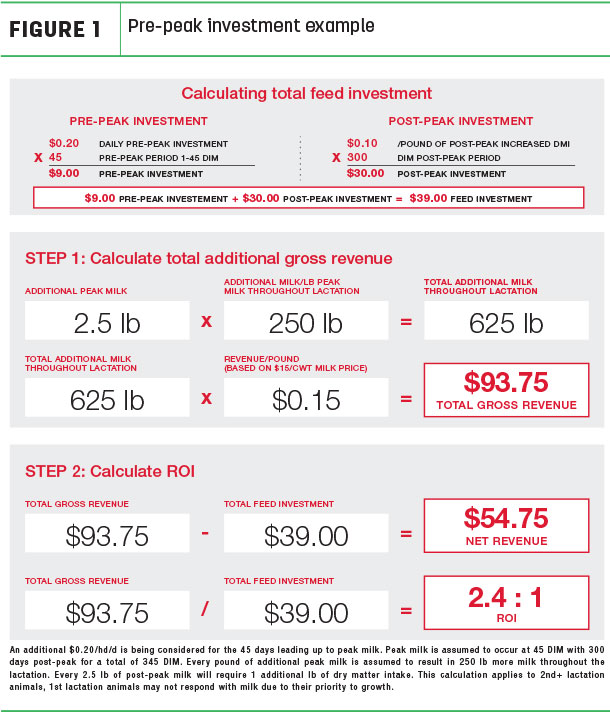The same concept applies to achieving peak milk. Reaching the highest point on the mountain (or lactation curve) is the goal. It takes a strong nutrition plan, a focus on management and long-term thinking to get there. And once you’ve achieved higher peak milk, there’s value in capturing additional milk in the post-peak phase.
Here are five things to consider as you scale the peak milk mountain:
1. Set benchmarks
Before you start climbing, you must know your destination. Set peak milk goals based on your herd’s tank average goal.
For example, to achieve a 100-pound tank average, first-lactation cows should peak at 100 pounds of milk, and second-lactation cows should make 100 pounds or higher on their first milk test, then expect a 3% to 4% post-peak monthly decline for first-lactation and 6% to 7% for second- and greater-lactation animals.
The timing to reach your goals is also a factor. Milk secretory tissues begin to decline post-peak, resulting in a milk production drop. First-lactation animals should peak at 60 to 90 days in milk (DIM) while second-lactation or higher animals should peak at 30 to 60 DIM.
2. Think long term
Deciding when and how much to invest in the pre-peak period can be a difficult decision. Many farmers shoot for a 2-to-1 return on investment (ROI) in the pre-peak period. But a long-term perspective can help achieve additional value.
Think about it this way: You only invest in nutrients to support higher peak milk for about 45 days for mature cows. Then cows have 300 days or more post-peak to pay back that investment. For every additional pound of peak milk per cow, you can expect 200 to 250 pounds more milk per cow over the entire lactation.
Let’s crunch the numbers. If you invest an additional 20 cents per cow per day in feed costs for the pre-peak period to gain 2.5 pounds more peak milk per cow, you could achieve $54.75 additional net revenue per cow for the full lactation, or a 2.4-to-1 ROI (Figure 1).

Apply the math across 500 cows, and you could make an additional $27,375 net revenue for the entire lactation.
3. Invest in pre-peak nutrition
A 2.4-to-1 ROI over the full lactation starts with feeding the right nutrition pre-peak. Fresh cows have lower feed intake than later-lactation cows at the same production level. A more nutrient-dense diet helps support milk production, even with reduced consumption.
Starch, fat, metabolizable protein (MP) and amino acids are key to drive peak milk production. Prioritizing forage harvest management, quality, fermentation and feeding management can help increase intake and lead to higher milk production.
Cow management also plays a central role in milk production. Before investing in a pre-peak nutrition plan, make sure cows have a clean, comfortable environment, adequate water access and resting time, and minimized time away from the pen.
4. Support fresh cow health
It takes a lot of energy to get to the summit. Health challenges, especially in the transition period, can divert energy from milk production to help fight off diseases. The result? Lower milk production.
Support transition cow health and immune function with pre-fresh diet formulation. Attention to MP and calcium status (through dietary cation-anion difference [DCAD]) can help reinforce fresh cow health and milk production.
A DCAD formulation approach to support calcium metabolism can help cows navigate through the critical transition period. The nutrition investment to support fresh cow health can easily result in additional peak milk.
5. Manage body reserves
Maintaining appropriate body condition during the dry and pre-fresh periods is important to support peak milk production. Too much weight can reduce feed intake and put cows at a higher risk for fresh cow diseases. On the other hand, an underconditioned cow might not have the reserves necessary to support higher milk production and reproductive efficiency.
Target a 3 to 3.5 body condition score (BCS) for second-lactation-or- greater cows and a 3.25 to 3.75 BCS for first-lactation heifers.
This may require reduced energy density to be reduced in the diet for late-lactation cows to better manage body reserves when they enter the dry period.
Every herd, just like every mountain, has its challenges and goals. Work with your local nutritionist to help your herd maximize peak milk and reap the most value on the way down. ![]()
ILLUSTRATION: Illustration by Corey Lewis.
Kevin Dill, Ph.D., is a senior nutritionist with Purina Animal Nutrition.

-
Kevin Dill
- Senior Nutritionist
- Purina Animal Nutrition
- Email Kevin Dill






